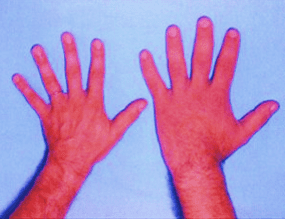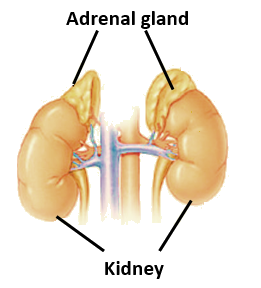Introduction
The endocrine system consists of many organs such as glands, that include the thyroid, adrenal, parathyroid, pituitary, thymus, hypothalamus, pancreas, and pineal. Hormones, which are chemical messengers secreted by these glands, are responsible for the coordination of different organ systems of the body. Endocrine diseases are caused by either insufficient or excessive secretion of hormones. The pituitary gland, a tiny organ on the underside of the brain, secretes the hormones like growth hormone (GH) and somatotropin, which control bone and muscle growth as well as height. Acromegaly, which alters the body’s appearance, results from GH hypersecretion.
What is Acromegaly?

Acromegaly is a rare hormonal condition brought on by the pituitary gland’s ongoing hypersecretion of growth hormone (GH). The increased GH secretion in adults causes the hands, feet, and face to have larger bones. It results in enlarging of the hands, feet, and face.
What are the Causes of Acromegaly?
When the pituitary gland secretes too much GH into the blood, the liver is signalled to generate an additional hormone called insulin-like growth factor-1 (IGF-1). It controls how bones and other tissues grow. Acromegaly results from the IGF-1 being triggered by greater levels of GH. Acromegaly in adults has been linked to tumours such as non-pituitary and pituitary tumours.
Pituitary tumours: It is an adenoma of the pituitary gland, a non-cancerous tumour. It secretes an excessive amount of the GH hormone, which results in acromegaly symptoms. This tumour grows slowly and takes a while to become apparent. The tumour pressing on nearby brain regions may cause headaches and vision loss.
Non-pituitary tumour: It is a tumour that has grown in the pancreas, lungs or other parts of the chest. This is an uncommon tumour instance. While this tumour occasionally secretes growth hormone (GH), more frequently it releases growth hormone-releasing hormone (GH-RH), which causes the pituitary gland to release excessive amounts of GH.
Acromegaly Symptoms
Acromegaly can cause a variety of symptoms, but the most prevalent ones are swollen hands and feet. The symptoms can include the following and are recognizable.
- Enlarged facial characteristics include the face bone, nose, lips, and tongue.
- Excessive sweating and odour from the skin
- Very thick, greasy, and coarse skin
- Aching joints
- Headaches
- Distorted vision
- Expansion of skin tags
- Deep voice
- Fatigue and weakened muscles
- The separation between teeth
- Gaining weight
- Hands and feet tingle and have no feeling
- Abnormal female hair growth
- Unreliable menstrual cycles
- The effects of abnormal thyroid hormones on skin, hair, and weight
- Male erectile dysfunction
Facts About Acromegaly
- Acromegaly is a term for growth hormones and tumour-related enlargement.
- It is typically brought on by a benign tumour called a pituitary adenoma, which is found on the anterior lobe of the pituitary gland.
- It is not a genetic illness and only affects people in their middle years.
- Children who experience an increase in GH exhibit gigantism.
- Acromegaly is a dangerous illness that can cause blindness in its victims.
- The remedy is accessible and capable of averting serious consequences.
- Acromegaly is an uncommon illness that affects a very small number of people worldwide.
Acromegaly Diagnosis
Acromegaly is difficult to diagnose because the early signs are not always present. The results of the imaging and blood testing show that the person has acromegaly.
Blood tests:
IGF test: The blood level of GH often varies throughout a person’s lifespan. IGF levels are more consistent throughout the day than GH levels, even though GH and IGF-1 are closely related hormones. To determine the level of IGF hormone in the blood, a blood test is used.
Oral glucose tolerance test: Using this test, you may see how your growth hormone levels respond to changes in blood sugar. Several time intervals can pass after consuming the glucose solution before the blood is drawn. Drinking sugar typically lowers GH levels, but if someone has acromegaly, GH levels won’t drop.
Imaging tests:
The imaging tests are used to pinpoint the tumour’s site and track its expansion. Two imaging exams exist:
- MRI (Magnetic resonance imaging): To determine the location and size of the pituitary tumour, an MRI scan is used. To obtain an in-depth image of the inside organs and tissues, radio waves and magnets are employed.
- Computerized tomography (CT): If an MRI scan is not possible, a computerized tomography (CT) scan is performed to get images of the inside organs and tissues.
Treatments
Acromegaly-related long-term consequences can be avoided by the patient with certain treatments. Some of these remedies include
- Surgery: The location and size of the tumour affect the course of treatment. Only surgery is required if the tumour is to be eliminated. However, if only a portion of the tumour is removed after surgery, chemotherapy and radiation treatment are still required.
- Chemotherapy: Drugs and injections are used to control hormone levels and treat symptoms that help the body return to normal.
- Radiation therapy: Radiation therapy is used to treat acromegaly when medicine and surgery are ineffective. Through sophisticated equipment, it allows the radiation beams to reach the target tumour’s location. Although it can lower the level of growth hormone, the full effects don’t appear for several years.
Summary
Acromegaly is a rare hormonal condition brought on by the pituitary gland’s ongoing hypersecretion of growth hormone (GH). Acromegaly results from IGF-1 being triggered by higher levels of GH. Acromegaly can cause a variety of symptoms, but the most prevalent ones are swollen hands and feet. It is not a genetic illness and only affects people in their middle years. Drugs and injections are used to control hormone levels and treat symptoms that help the body return to normal.
Frequently Asked Questions
1. How is Gigantism related to Acromegaly?
Ans. Acromegaly and gigantism are both GH (growth hormone) diseases. Hormonal issues result from the pituitary gland’s excessive GH production. However, their signs and symptoms vary.
2. What is the Glucose Tolerance Test Conducted in Acromegaly?
Ans. Using this test, you may see how your growth hormone levels respond to changes in blood sugar. Several time intervals can pass after consuming the glucose solution before the blood is drawn. Drinking sugar typically lowers GH levels, but if someone has acromegaly, GH levels won’t drop.
3. Who gets Acromegaly and how Frequent is it?
Ans. Acromegaly is a rare genetic condition. It is a rare condition that can occur in middle-aged people if they produce too much GH.
4. What is Pituitary Adenoma?
Ans. A pituitary adenoma is an adenoma of the pituitary gland, a non-cancerous tumour. It secretes an excessive amount of the GH hormone, which results in acromegaly symptoms. This tumour grows slowly and takes a while to become apparent.
